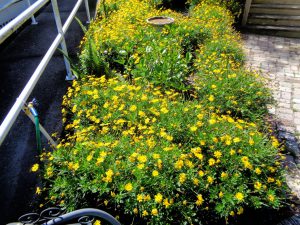
I like to highlight public places to see plants, and besides our own Master Gardener Volunteer Demonstration Garden on Harborview Road, and the Nature Park in Punta Gorda, the History Park is another place to enjoy a well-cultivated landscape. During a recent visit to the History Park I found a wonderful mass-planting of bush daisies. If you like small perennial shrubs with daisy-like flowers, you will love this flowering plant. I have written about bush daisies before, but wanted to reintroduce this Florida-Friendly Landscaping™ recommended plant due to its hardiness, low-maintenance, and highlight this particularly spectacular display. You will adore this easy-to-care-for plant!
Although there are couple of similar types of plants available on the market often interchangeably called “African bush daisies”, let’s simply call this African native plant “bush daisy” as an over-arching name to simplify what you find in local garden centers. The bush daisy is well-suited in our area and is known for its green, feathery, fern-like foliage which makes an excellent backdrop for the bright yellow flowers. This plant is in the Aster family and can flower year-round growing two-feet tall and three feet wide over time actually making it a small shrub of sorts. The yellow bush daisy is an excellent choice for mass planting with individual plants set at twenty-four-inch intervals. In addition to mass planting, consider the bush daisy as a stand-alone specimen in rock gardens, in borders, as a container plant or to line foundation beds. Bush daisies are also known to attract butterflies and other pollinators.
Select a full-sun sight for planting in average, but well-drained soil. Water to establish these plants, and then only as needed. A two-to-three-inch mulch will help retain moisture and allow this medium drought-tolerant plant to thrive at its best. The bush daisy can sometimes develop yellow foliage due to lack of iron in our often-alkaline soils. You can correct this with a chelated iron foliar nutrient spray being careful as this material will stain concrete and stonework. Keep in mind that bush daisies have a low to poor tolerance to salt, so avoid those coastal planting conditions.
While bush daisies technically can flower year-round, cold weather and freezes may damage some of the foliage and reduce the flowering during the winter. Any damaged/dead foliage can be pruned out in the spring and re-sprouting will occur fairly rapidly. Bush daisies propagate easily by seed – you may even find that seeds have dropped and sprouted around the mother plant as volunteers.
Bush daisies are readily available at all local garden centers. A pot or two of yellow bush daisies makes a nice surprise gift for both your favorite gardener and yourself! For more information on all types of flowering plants suitable for our area, or to ask a question, please visit https://www.facebook.com/CharlotteCountyExtension . You can also call the Master Gardener Volunteer Helpdesk on Mondays, Wednesdays and Fridays from 1 to 4 pm at 764-4340 for gardening help and insight into their role as an Extension volunteer. Ralph E. Mitchell is the Director/Horticulture Agent for UF/IFAS Extension Charlotte County. He can be reached at 941-764-4344 or ralph.mitchell@charlottecountyfl.gov.
Resources:
Gilman, E. F. & Landrum, L. (2015) Gamolepis chrysanthemoides African Bush Daisy. The University of Florida Extension Service, IFAS.
The Florida-Friendly Landscaping™ Guide to Plant Selection & Landscape Design (2010) The University of Florida Extension Services, IFAS.
UF/IFAS Gardening Solutions (2018) – Bush Daisy – The University of Florida Extension Service, IFAS.
Grant, B. L. (2022) Daisy Bush Care: How To Grow An African Bush Daisy. Gardening Know How.
 1
1
